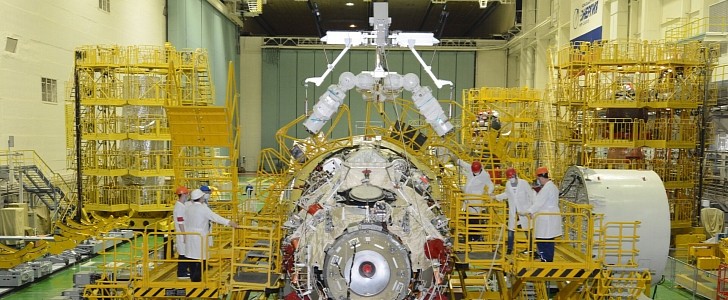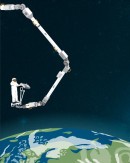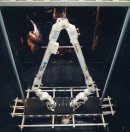The European Robotic Arm (ERA) is ready to lend its lengthy hand to the astronauts on the International Space Station (ISS). It will be launched next month from Russia.
The European Space Agency (ESA) recently announced the launch date of the robotic arm on the ISS, and that date is July 15. The ERA will be launched at 7:18 pm CEST (Central European Summer Time) on a Proton rocket. The departure location is the Russian launch base Baikonur.
As stated by the ESA, the robotic arm was designed and assembled by Airbus Defence and Space Netherlands and is 100 percent made in Europe. The robotic arm has a length of 37 feet (11.3 m) and a reach of 31.8 ft (9.7 m). It is made of carbon fiber and aluminum and is equipped with multiple cameras and lighting units.
The robotic arm has a maximum speed of operations of 3.9 inches/second (10 cm/s) and a launch mass of 1,388 lbs (630 kg). It has a handling capacity of more than 17,600 lbs (8,000 kg). The ERA will be the latest robot to service the International Space Station on the Russian Space Station segment and can anchor itself to the ISS in multiple locations. It has a wide range of motion, being capable of moving forward and backward.
The International Space Station already has two robotic arms: Canadarm2 and the Japanese Experiment Module Remote Manipulator System. However, none of them can reach the Russian segment of the Station.
The robotic arm can handle a variety of tasks, easing the burden on astronauts and allowing them to focus on other work during their spacewalks. It can be used for transporting crew members from one external working site to another. Its cameras can also be used to inspect the outside of the Space Station. Thanks to its huge handling capacity, the ERA can also install, remove, and replace large elements on the Space Station, as well as experiment payloads. It can also transfer small payloads in and out of the ISS via the Russian airlock.
As stated by the ESA, the robotic arm was designed and assembled by Airbus Defence and Space Netherlands and is 100 percent made in Europe. The robotic arm has a length of 37 feet (11.3 m) and a reach of 31.8 ft (9.7 m). It is made of carbon fiber and aluminum and is equipped with multiple cameras and lighting units.
The robotic arm has a maximum speed of operations of 3.9 inches/second (10 cm/s) and a launch mass of 1,388 lbs (630 kg). It has a handling capacity of more than 17,600 lbs (8,000 kg). The ERA will be the latest robot to service the International Space Station on the Russian Space Station segment and can anchor itself to the ISS in multiple locations. It has a wide range of motion, being capable of moving forward and backward.
The International Space Station already has two robotic arms: Canadarm2 and the Japanese Experiment Module Remote Manipulator System. However, none of them can reach the Russian segment of the Station.
The robotic arm can handle a variety of tasks, easing the burden on astronauts and allowing them to focus on other work during their spacewalks. It can be used for transporting crew members from one external working site to another. Its cameras can also be used to inspect the outside of the Space Station. Thanks to its huge handling capacity, the ERA can also install, remove, and replace large elements on the Space Station, as well as experiment payloads. It can also transfer small payloads in and out of the ISS via the Russian airlock.







